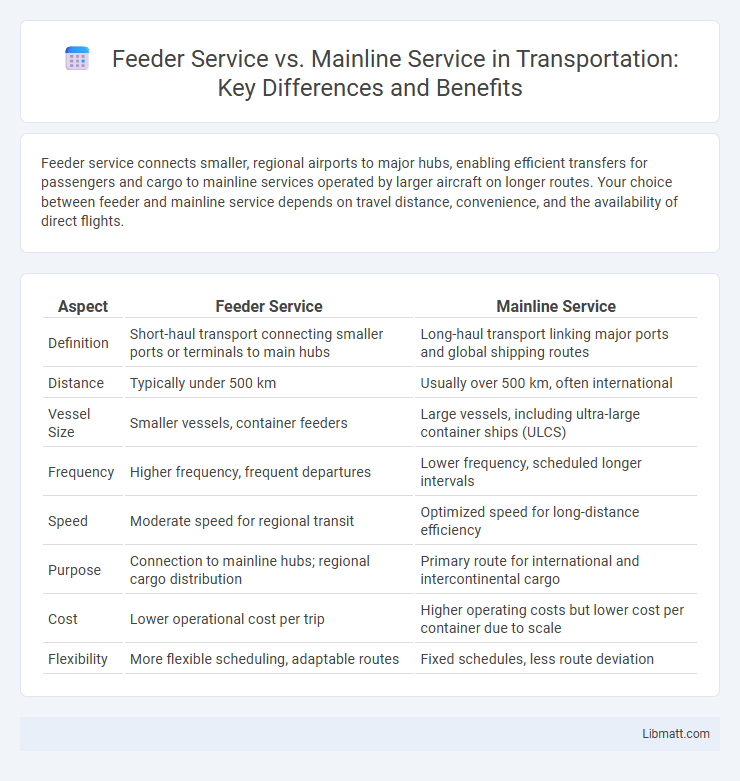Feeder service connects smaller, regional airports to major hubs, enabling efficient transfers for passengers and cargo to mainline services operated by larger aircraft on longer routes. Your choice between feeder and mainline service depends on travel distance, convenience, and the availability of direct flights.
Table of Comparison
| Aspect | Feeder Service | Mainline Service |
|---|---|---|
| Definition | Short-haul transport connecting smaller ports or terminals to main hubs | Long-haul transport linking major ports and global shipping routes |
| Distance | Typically under 500 km | Usually over 500 km, often international |
| Vessel Size | Smaller vessels, container feeders | Large vessels, including ultra-large container ships (ULCS) |
| Frequency | Higher frequency, frequent departures | Lower frequency, scheduled longer intervals |
| Speed | Moderate speed for regional transit | Optimized speed for long-distance efficiency |
| Purpose | Connection to mainline hubs; regional cargo distribution | Primary route for international and intercontinental cargo |
| Cost | Lower operational cost per trip | Higher operating costs but lower cost per container due to scale |
| Flexibility | More flexible scheduling, adaptable routes | Fixed schedules, less route deviation |
Introduction to Feeder and Mainline Services
Feeder services operate as local or regional transportation routes that connect smaller or remote areas to major hubs, facilitating the efficient movement of passengers or goods. Mainline services run along primary routes, often covering long distances between major cities or central terminals, forming the backbone of transportation networks. Understanding the distinction between feeder and mainline services helps optimize your travel or logistics planning by leveraging the strengths of each service type.
Defining Feeder Service
Feeder service refers to transportation operations that connect smaller, regional, or local markets to larger hubs or mainline routes, facilitating the efficient transfer of goods and passengers. This service typically operates on a smaller scale with shorter routes and smaller vehicles, optimizing last-mile delivery and regional access. Your logistics strategy benefits from feeder service by enhancing network reach and improving the flow between local areas and major mainline carriers.
Understanding Mainline Service
Mainline service refers to the primary air or shipping routes operated by major carriers connecting large hubs or international destinations directly. Your shipments or passengers benefit from faster transit times and more consistent schedules through mainline services, as these routes prioritize high capacity and streamlined operations. Understanding mainline service helps optimize logistics and travel planning by leveraging these core networks for maximum efficiency.
Key Differences Between Feeder and Mainline Services
Feeder services operate on short-haul routes, connecting smaller ports or airports to larger hubs served by mainline services, which handle long-haul, high-capacity transportation. Mainline services utilize larger vessels or aircraft to maximize efficiency on major trade lanes or routes, while feeder services use smaller, more flexible units for regional distribution. Understanding these distinctions helps you optimize logistics by leveraging feeder services for last-mile connectivity and mainline services for bulk transit.
Types of Vessels Used in Each Service
Feeder services typically utilize smaller vessels such as feeder container ships or barges designed for short-haul transport between smaller ports and larger hub ports. Mainline services rely on large, ocean-going vessels like ultra-large container ships (ULCS) and Panamax or Post-Panamax ships capable of carrying thousands of TEUs across long distances. The selection of vessels directly impacts operational efficiency, with feeder vessels providing flexibility in port access and mainline vessels offering economies of scale on major trade routes.
Route Structures and Port Coverage
Feeder service operates on shorter routes connecting smaller ports to major hub ports, enhancing regional port coverage and enabling efficient cargo consolidation. Mainline service runs longer, direct routes between major, deep-water ports, providing extensive global coverage and faster transit times for large shipments. Your logistics strategy benefits from integrating feeder services for last-mile connectivity and mainline services for main trade lane efficiency.
Cost Implications and Pricing Strategies
Feeder services typically incur lower operational costs due to shorter routes and smaller aircraft, making their pricing strategies more flexible and competitive to attract regional customers. Mainline services involve higher fixed and variable costs linked to longer distances, larger aircraft, and premium amenities, necessitating pricing strategies that reflect these increased expenditures while targeting higher revenue per seat. Optimizing the balance between feeder and mainline pricing structures is crucial for airlines to maintain profitability and market coverage efficiency.
Cargo Handling and Transit Times
Feeder service involves smaller vessels transporting cargo to main ports where mainline services handle larger shipments over long distances, resulting in different cargo handling efficiencies. Cargo handling in feeder services is typically faster due to smaller volumes and specialized regional terminals, while mainline services require more complex logistics for large-scale cargo transfers. You can expect shorter transit times with feeder services for regional distribution, whereas mainline services offer more direct routes but longer overall transit due to extensive international coverage.
Advantages and Disadvantages of Each Service
Feeder service offers cost efficiency and flexibility by connecting smaller ports to mainline hubs, enabling access to diverse markets with lower operational expenses, but it often involves longer transit times and limited capacity. Mainline service provides faster transit and higher cargo volumes through direct routes between major ports, benefiting your supply chain with reliability and speed, yet it demands higher costs and may lack reach to smaller or regional destinations. Choosing between the two depends on priorities like cost, speed, and geographic reach tailored to your shipping needs.
Choosing the Right Service for Your Shipping Needs
Feeder service operates by transferring cargo between smaller regional ports and major hub ports, ideal for businesses requiring flexible, cost-effective solutions for short distances or less frequent shipments. Mainline service provides direct, large-scale shipping between major international ports, suitable for high-volume, time-sensitive deliveries needing faster transit times and more reliable schedules. Selecting between feeder and mainline services depends on shipment volume, delivery speed requirements, and overall logistics strategy to optimize costs and ensure efficient distribution.
Feeder service vs Mainline service Infographic

 libmatt.com
libmatt.com